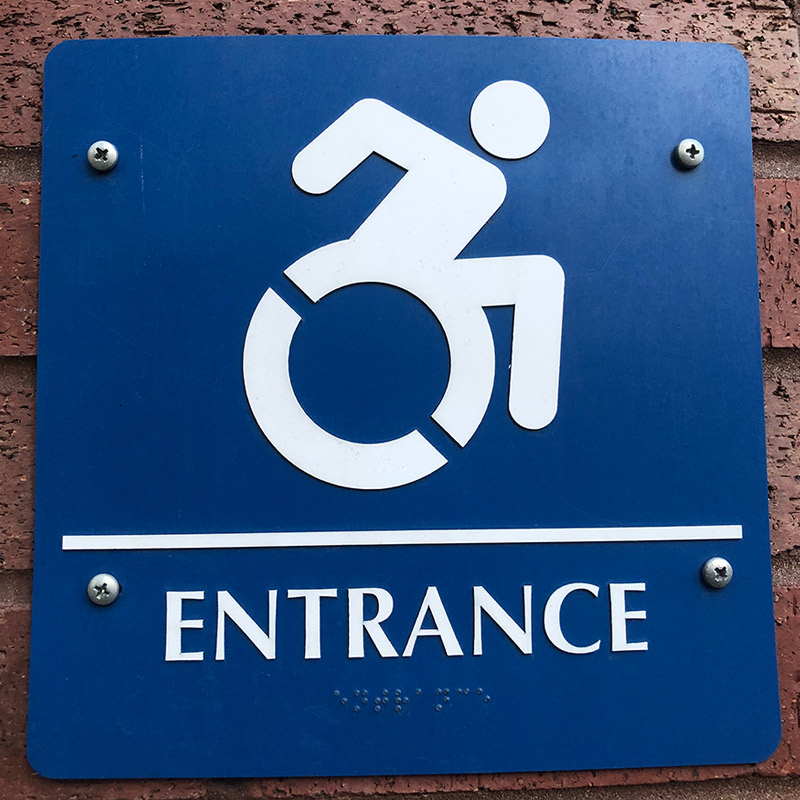The Role of ADA Signs in Following Availability Standards
The Role of ADA Signs in Following Availability Standards
Blog Article
ADA Signs: Making Sure Availability and Compliance in Public Spaces
ADA signs plays a vital role in guaranteeing accessibility and conformity within public rooms, significantly contributing to an inclusive environment for people with impairments. As we check out the subtleties of ADA signage, from responsive functions to design intricacies, it's important to think about exactly how these components coalesce to maintain the civil liberties of all individuals.
Importance of ADA Signs
In contemporary culture, the importance of ADA signs extends past mere conformity with lawful mandates to embody a dedication to inclusivity and access for all individuals. These indications are important in creating environments where people with handicaps can navigate public spaces with the very same simplicity and independence as those without impairments. By offering clear and standard details, ADA signs makes certain that every person can access centers, solutions, and info without barriers.
The relevance of ADA signage lies in its capacity to boost the quality of life for people with specials needs by promoting equivalent gain access to. It gets rid of the barriers that may or else impede their capacity to take part completely in community life. These signs serve as noticeable signs of a company's devotion to diversity and equal rights, reflecting more comprehensive societal values that promote the legal rights and dignity of all people.
Additionally, ADA signs plays a critical function in public security. By leading people to leaves, restrooms, and various other important centers, it makes certain that all individuals, despite physical capability, can leave safely throughout emergency situations. In summary, ADA signs is not just a regulative requirement yet an effective device for fostering a equitable and comprehensive culture.
Key Aspects of Compliance

Placement is crucial; signs must be set up in areas that are obtainable and conveniently visible. Commonly, signage needs to be mounted between 48 and 60 inches from the ground to ensure accessibility for both standing and mobility device customers. Tactile elements, such as Braille, are essential for people with aesthetic disabilities, providing vital info in a non-visual style.
High-contrast colors between the text and history are essential to enhance readability for people with reduced vision. The ADA mandates particular comparison proportions to make certain quality. Furthermore, character dimension is a vital consideration, with minimum elevation needs dictated by the seeing distance to make sure readability from numerous angles.
Style Considerations for Availability
Creating accessible signs requires a thorough strategy to ensure it fulfills the needs of all users, especially those with disabilities. This entails thinking about different layout components that enhance readability and use. Key factors include the option of font style, color comparison, and responsive features. Font styles ought to be sans-serif, with clear and basic letterforms, to help with very easy reading. The dimension of the text is similarly vital, with ADA standards advising a minimal height based upon seeing distance to make sure clarity.
Contrasting colors in between text and background are crucial for presence, specifically for individuals with visual problems. A high contrast ratio helps differentiate the message from its background, boosting readability under various illumination conditions. Additionally, responsive components, such as Braille and elevated personalities, are vital for individuals that are blind or have reduced vision. These components ought to be found at a constant elevation and setting to ensure very easy accessibility and understanding.
Additionally, the positioning of signs plays a significant duty in accessibility. Signs ought to be installed in locations that are unblocked and conveniently reachable. Making certain that signage is mounted at appropriate heights and angles makes it possible for all users, consisting of those using wheelchairs, to communicate with them effectively.
Common Blunders to Prevent

Another widespread mistake is the inaccurate positioning of signage. ADA guidelines specify accurate height and Get the facts location requirements to ensure that signs are obtainable and quickly noticeable by all people, consisting of those utilizing mobility devices. Ignoring these standards not only hampers access however additionally runs the risk of non-compliance with legal requirements.
In addition, not enough contrast in between text and history is a frequent oversight. Sufficient comparison is crucial for readability, particularly for people with low vision. Designers in some cases select shades that are aesthetically appealing but lack the required comparison, making the message challenging to recognize.
Finally, some developers fall short to include responsive aspects, such as Braille, which are vital for people that are blind. Omitting these attributes not only causes non-compliance with ADA guidelines but additionally restricts accessibility for a segment of the populace that counts on responsive information.
Future Trends in Signage
Innovations in innovation and boosting understanding of inclusivity are forming the future fads in signs style. As society becomes more aware of varied needs, the integration of wise modern technologies right into signage is acquiring grip. Digital signage, for example, is advancing to consist of real-time updates and interactive attributes, which can be critical in providing vibrant details in public rooms. These indications commonly include touch displays or gesture-based controls, allowing customers to browse content tailored to their details demands.
Another arising fad is the usage of increased truth (AR) to enhance customer experience. AR-enabled signage can overlay electronic details onto the physical setting, visit providing aesthetically impaired people with auditory or haptic comments. ADA Signs. This innovation not only boosts ease of access yet additionally creates an engaging experience for all users
Sustainability is likewise a significant element affecting signs fads. Eco-friendly products and energy-efficient lights options are being focused on to line up with international ecological objectives. Additionally, improvements in materials scientific research are causing the advancement of even more resilient and weather-resistant indications.
Conclusion
ADA signs plays a crucial role in guaranteeing accessibility and conformity within public spaces by including tactile aspects, high-contrast shades, and critical placement. The adherence to ADA criteria not just facilitates secure navigation for people with impairments yet also signifies a company's dedication to diversity and inclusivity. By preventing usual blunders and accepting future patterns, public spaces can remain to advance these worths, ensuring that the rights and dignity of all people are valued and maintained.
ADA signage plays an essential role in ensuring ease of access and conformity within public rooms, dramatically contributing to an inclusive environment for people with disabilities. As we explore the nuances of ADA signs, from tactile attributes to create ins and outs, it's vital to take into consideration exactly how these components coalesce to copyright the civil liberties of all individuals.In contemporary culture, the significance of ADA signs prolongs beyond plain compliance with lawful requireds to embody a dedication to inclusivity and ease of access for all people. By offering standardized and clear information, ADA signage makes certain that everybody can access facilities, solutions, and info without obstacles.
ADA signage plays an important role in guaranteeing ease of access and conformity within public areas by including responsive components, high-contrast colors, and calculated positioning. (ADA Signs)
Report this page